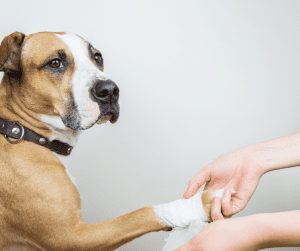Dog First Tips For Dogs.
Dogs can suffer accidents or injury at any time, so it is important to feel confident and prepared in case of any emergency that may arise. In this Holidays4Dogs article we provide a few hints and tips on some of the most common situations that may involve first-aid for your dog, or someone else’s. We also advise on what to include in a dog first aid kit.
It can be a frightening situation when a beloved pet suffers an accident, or injury. However, the main thing to remember is to remain as calm as possible.
situation when a beloved pet suffers an accident, or injury. However, the main thing to remember is to remain as calm as possible.
While time is often of the essence, try to go through check-points calmly and methodically. If you are in any doubt, always seek the advice of a veterinarian.
Thankfully, most dogs can navigate life without getting into too many scrapes. They are resilient animals and will often brush off minor cuts and bruises as if nothing had happened.
However, in certain circumstances, owners may need to intervene and administer basic first aid to keep the dog comfortable.
What should I include in a canine first aid kit?
Just as it is as important for us to have a first-aid kit handily available, the same is true for our dogs. It’s a good idea to keep a kit at home and if you travel with your dog regularly, keep one in the car too. The main items to include in your dog’s first aid kit are; –
-
Bandages.
-
Cotton wool/gauze swabs.
-
Self-adhesive tape.
-
Wound pads.
-
Saline pods.
-
Foil blanket.
-
Gloves.
-
Antiseptic wipes (alcohol free).
-
Tweezers/tick hooks.
-
Blunt-ended scissors.
-
Aloe Vera gel.
You can make up your own kit, or they can be purchased from various pet outlets. We like this one as it has everything from alcohol wipes to an emergency blanket.
Some common accidents and injuries.
 It’s always good to be prepared and, along with a fully stocked first aid kit and a bit of prior knowledge, you should be able to address minor injuries and accidents at home.
It’s always good to be prepared and, along with a fully stocked first aid kit and a bit of prior knowledge, you should be able to address minor injuries and accidents at home.
However, do remember even with minor injuries, your dog may feel discomfort and stress and may be more inclined to bite.
You should be even more cautious with dogs you do not know. You can make a home-made temporary muzzle with a piece of bandage. Wrap it firmly, (but not too tightly) around the dog’s muzzle, then secure behind the ears.
Here are some minor injuries you and your dog may encounter; –
Burns.
Minor burns caused by hot liquid, for instance, can be treated at home – but will need immediate attention. Clean the area thoroughly with a clean cool cloth and apply a soothing gel such as aloe vera. More serious burns from boiling water, or chemicals, will need urgent veterinary treatment and you should take your dog immediately to the surgery.
Cuts and minor wounds.
For superficial cuts and scrapes clean the area with antiseptic wipes, or a clean cloth, to remove any debris. If the dog has stepped on broken glass, make sure there is none left in the skin and use tweezers to remove any shards.
If the cut is bleeding, you can apply pressure with a cotton wool pad and, if necessary, apply a bandage. Monitor the wound carefully to make sure it shows no signs of further infection, such as clear, or yellow pus. If the cut is very deep, or bleeding profusely, prompt veterinary attention must be sought.
Dog bites.
Dogs that suffer bite wounds as a result of fighting with another dog must be checked over thoroughly by a vet. While minor cuts can be treated at home, more serious open wounds will need further investigation by a vet.
Larger wounds can be rinsed with a saline solution and covered with a gauze bandage prior to seeing a vet. Dog bites can readily cause secondary infection, so a visit to the vet, regardless of severity, would be wise.
Broken/fractured claws.
Damage to claws can happen fairly commonly. Dogs can often ‘snag’ claws while he is running, or twisting, on rough ground. Sometimes, they can can get caught in fabric too. Long nails can become dry and brittle and, therefore, can break more easily. Aim to keep your dog’s nail trimmed. If you are confident, you can do this yourself at home. Alternatively, your vet or a grooming parlour, can trim your dog’s claws.
The dog’s nail consists of blood vessels and nerves known as the ‘quick’ so it can be quite painful if they break. If the nail bleeds, it’s important to control this by applying a compress. Use a veterinary caustic silver nitrate stick, which will help stop the bleeding.
Where a break in a dog’s claw is particularly nasty, veterinary treatment and antibiotics may be required.
Insect stings. 
This can usually be treated at home and you can read more detail about bee and wasp stings in dogs here.
The exception is, if the dog has been stung in the mouth, head or neck area. In this case, it is very important for the dog to be assessed by a vet straight away.
For information on other first aid situations, you can read a previous article by Holidays4Dogs here.
When should I contact my vet?
You should contact your vet at any time you feel worried about your dog, however minor the injury seems. For other symptoms such as these below, you must seek immediate veterinary attention; –
-
Profuse bleeding.
-
Difficulty breathing.
-
Excessive panting and pale (blue) gums.
-
Seizure.
-
Vomiting.
-
Lack of balance.
Any of the above signs call for urgent attention from your vet. Always have the number handy in your phone and first aid kit. The hints and tips contained in this article do not replace advice and treatment by a qualified vet. Always seek veterinary attention for any matters concerning your pet’s health.
Holidays4dogs.co.uk and 4Dogs are participants in the Amazon Services LLC Associates Program, an affiliate advertising program designed to provide a means for sites to earn commission fees by advertising and linking to the following websites. Read our full disclosure agreement here https://www.holidays4dogs.co.uk/affiliate-disclosure/



